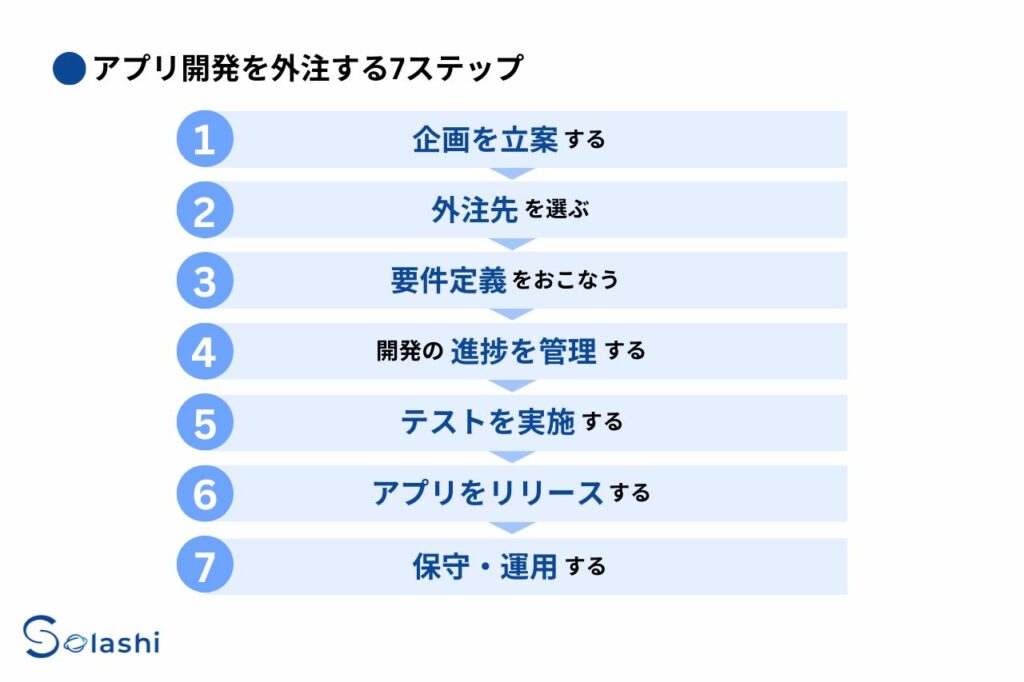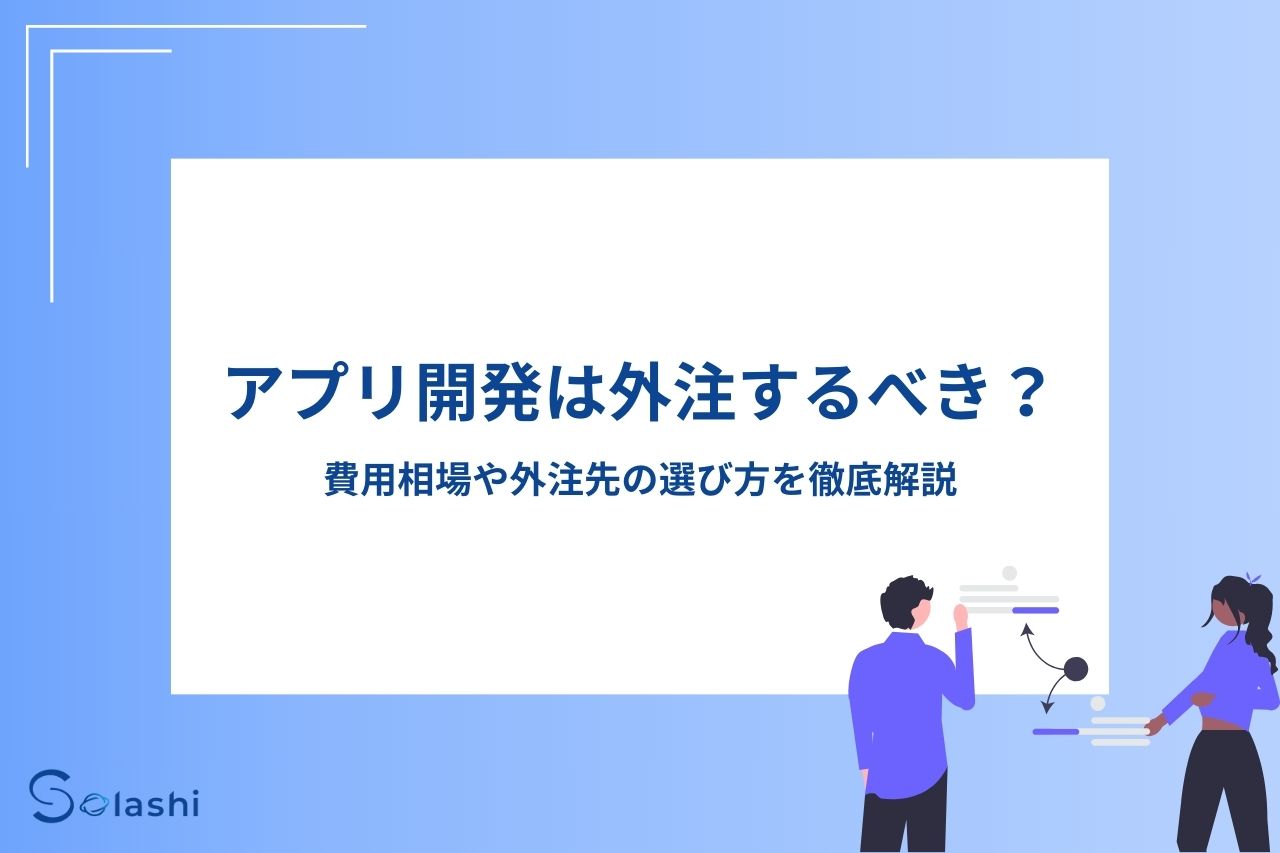“I don’t know how to proceed with outsourcing app development” or “I’m unsure whether I should outsource.”
“I want to know the key points for choosing an outsourcing partner.”
Some people may have these concerns when it comes to outsourcing app development.
This article explains not only the advantages and disadvantages of outsourcing app development, but also how to choose a development company and the general cost ranges. We’ve covered everything from specific selection points to cost-saving tips. If you’re struggling with whether to outsource app development, be sure to use this article as a reference.

Akira Shimazoe
CEO of Solashi Japan LLC. Engaged in the development and operation of internal systems at Suntory. Founded Yper Inc., serving as CTO and CPO, contributing to product launch and growth.
3 Advantages of Outsourcing App Development
There are three main advantages of outsourcing app development:
- You can develop without having internal know-how or skills
- You can expect a certain level of quality
- You can also outsource post-launch operation and maintenance
Let’s take a closer look at each advantage.
1. You Can Develop Without Having Internal Know-How or Skills
Even if your company lacks app development know-how, outsourcing allows you to make it happen. App development requires specialized knowledge, experienced personnel, and a solid development structure, all of which take significant time and cost to build from scratch internally.
Development companies assign the right people to meet client needs and use their expertise and experience to bring the app to life. Additionally, if your needs or requirements are unclear, using consulting services can help with analyzing and organizing issues, and proposing optimal features and specifications.
By outsourcing, even companies without in-house knowledge can proceed with app development efficiently.
2. You Can Expect a Certain Level of Quality
By hiring a trusted development company, you can ensure your app is developed with a guaranteed level of quality. System development companies have structures in place to ensure quality. These include reviews during the requirement definition and design phases, and thorough testing processes to maintain high quality.
With such a quality management system, app development can meet predefined quality standards.
3. You Can Also Outsource Post-Launch Operation and Maintenance
Some development companies also handle post-launch operations and maintenance. If the same company that developed the app handles maintenance, they can act quickly and appropriately since they’re familiar with the system structure.
Outsourcing operations and maintenance also helps conserve internal resources. This work includes system monitoring, bug fixes, updates, and other ongoing tasks that require dedicated personnel. By outsourcing, your internal team can focus on other tasks.
To ensure smooth operation post-launch, we recommend outsourcing everything from development to maintenance.
Disadvantages of Outsourcing App Development
There are also disadvantages to outsourcing app development:
- No know-how is accumulated internally
- Costs may increase
When outsourcing, it’s important to understand these disadvantages and consider how to approach outsourcing appropriately. Let’s explain each point.
No Know-How is Accumulated Internally
The biggest drawback of outsourcing app development is that no know-how is retained in-house. Internal members miss out on opportunities for growth since they aren’t involved in the development process.
If it’s a one-time project or there’s no need to train personnel, this may not be an issue. But if your company aims to build its own development structure, consider joint development, tech exchange events, or partially internalizing processes to gain know-how.
Costs May Increase
Be cautious of cost risks when outsourcing to development companies. The cost of app development varies greatly depending on the type of app, required features, and engineer’s hourly rates. Poor selection of vendors can lead to unexpectedly high costs.
Also, if many changes or revisions occur during development, the timeline may extend, increasing labor costs. It’s vital to align expectations with the development company in advance regarding cost breakdowns and how additional costs are calculated. By being aware of cost risks and aligning clearly beforehand, you can prevent avoidable problems.
7 Steps to Outsource App Development

Here, we’ll introduce the typical process for outsourcing app development. The overall flow consists of 7 steps. Let’s go through each one.
1. Plan the Concept
The first step is to plan the app development concept. Clarify your goals, target users, and desired features in preparation for communicating with vendors. Be sure to consider the following:
- Purpose of the app
- Target audience
- App concept and ideas
If you proceed with a vague plan, it may lead to rework or issues later on. Ensure you have a clear and specific plan to facilitate smooth communication with the development company. Thorough planning at this stage significantly affects the overall success of the development.
2. Choose an Outsourcing Partner
Once the plan is solidified, choose a development company to outsource to. Based on the selection criteria described later, identify the most suitable partner for your company. Evaluate not only technical skills but also communication skills and the fairness of the estimate.
If you choose a reliable partner, you can expect smooth project progress and high-quality results. On the other hand, careless selection can lead to rework and other issues, so choose carefully.
3. Define Requirements
After selecting a vendor, move on to the requirement definition phase. Requirement definition is the process of documenting the desired features and performance of the app to be developed. Clearly communicating your needs to the vendor is crucial to avoid misunderstandings.
If your company lacks experience in app development, it’s also a good idea to seek help from the vendor during this stage. Keep communication tight and aim for a consistent requirement definition.
4. Manage Development Progress
Once development starts, regularly share updates and monitor progress. While the vendor leads the actual development, it’s important to hold regular progress meetings to share schedules and challenges. If requirements change during development, quickly discuss and respond with the vendor. Strengthen collaboration with the vendor through thorough information sharing.
5. Conduct Testing
After development is completed, move into the testing phase. App development testing is usually divided into four types:
- Unit testing
- Integration testing
- System testing
- Acceptance testing
Unit and system tests are primarily conducted by the development company, but regular progress meetings should be held to confirm the status of testing. Ask questions or raise concerns during these meetings as needed.
After vendor testing is complete, perform acceptance testing internally. It’s crucial to check usability and compliance with specifications from an end-user perspective. Quickly provide feedback on any bugs or improvements found during acceptance testing and request fixes. The testing phase greatly affects the final product’s quality. Make sure you allocate enough time and conduct it thoroughly.
6. Release the App
After testing and ensuring the app meets quality standards, it’s time to release the app…
Source: PR TIMES “Is app development really over 20 million yen? Survey on the realities of app development” by Pentagon Inc.
To get a good sense of pricing, the most reliable method is to request estimates from multiple development companies and compare them. By clearly communicating your requirements and carefully examining each quote, you can get an accurate idea of appropriate costs.
Tips for Reducing App Development Costs
Here are some tips for reducing app development costs. The key points are the following four:
- Clarify your requirements
- Narrow down the scope of the request
- Utilize subsidies
- Leverage offshore development
Clarify your requirements
If you sign a contract with vague requirements, additional work due to revisions and spec changes may result in extra labor. This can inflate the development cost, potentially exceeding the initial budget. By clarifying requirements at the request stage, you can minimize the risk of changes. As a checklist, make sure to specify the following:
- Purpose of the app development
- Design
- Required features
- Performance and security needs (non-functional requirements)
- Development period and schedule
- Maintenance and management
- Personnel required for implementation
When defining requirements, it’s crucial to describe them as specifically as possible to prevent misunderstandings with the development company. Avoid vague expressions and use numbers or examples for clarity.
Narrow down the scope of the request
Limiting the scope of the outsourced work is also effective in reducing outsourcing costs. Focus on parts that require external help, and consider handling other parts in-house. For example, your team can handle the design internally or outsource it to another designer.
However, attempting too much in-house work without adequate expertise may compromise the app’s quality. This can actually worsen the cost-effectiveness. Decide on role-sharing in consultation with the development company.
It’s also important to review the necessary features for your app and prioritize them. A good strategy is to include only the essential features in the initial release and add more features incrementally later.
Utilize subsidies
In some cases, part of the app development cost can be covered by subsidies. For example, the “Monozukuri Subsidy” is a support program available to a wide range of businesses. This subsidy covers industries such as service, retail, construction, travel, and more.
The following app development objectives are eligible for the Monozukuri Subsidy:
- Efficiency and advancement of innovative production processes and service delivery through IT utilization
- Promotion of innovative products and service development in DX and GX sectors
- Improving domestic productivity through overseas expansion
We explain the application procedures and conditions in detail in the following article. Please take a look if you’re interested.
【2024 Latest】What is the Monozukuri Subsidy? Full explanation of conditions and how to apply
Leverage offshore development
By using offshore development, you can significantly reduce development costs. Offshore development refers to outsourcing system development to companies overseas. By outsourcing to countries with lower labor costs than Japan, overall development expenses can be minimized.
Especially in countries like Vietnam, where there is an abundance of IT talent, you can access highly skilled developers at relatively low costs. However, challenges such as communication difficulties due to language and cultural differences must be considered. Therefore, it’s important to choose a company that can communicate in Japanese and has extensive offshore development experience.
At our company, Solashi Co., Ltd, we have several Japanese project managers with experience in launching businesses and handling startup projects. Even if it’s your first time outsourcing development overseas, you can rest assured. We offer high-quality app development at affordable prices. Please visit our website if you’re interested.
Japanese PMs Handle Communication
Looking for an Offshore Development Company
For such individuals, we recommend Solashi’s Vietnam offshore development
How to Choose an App Development Company
Here are four key points to consider when choosing an app development company.
- Do they have relevant development experience?
- Is communication smooth and easy?
- Do they offer post-development support?
- Is their security system reliable?
Do they have relevant development experience?
First, check the company’s development track record. Especially look for experience in the app category you aim to build. A company with broad experience may also be able to provide valuable advice from the planning stage. In general, companies with a strong track record pose less risk for rework during development.
We recommend checking their website to review past achievements and areas of expertise. Companies with experience relevant to your requirements are more likely to deliver high-quality apps. Reviewing their portfolio is a crucial part of evaluating their development capabilities, so try to gather as much information as possible.
Is communication smooth and easy?
Good communication is key to building a high-quality app. Especially if your company lacks technical expertise, it’s better to work with a company that listens carefully and actively proposes solutions.
During the inquiry and hearing stages, pay attention to how well they understand your business, the accuracy of their suggestions, and how clearly they explain things. If communication is smooth during development as well, the process will likely be efficient with fewer setbacks. Try talking to several companies to find the one with the best communication style for your team.
Do they offer post-development support?
When choosing a company, it’s also crucial to consider post-launch maintenance and support for issues like bugs. Especially if your company lacks sufficient operational resources, choose a provider with a solid support structure.
A company involved in the development process will be well-versed in the system’s specifications and can provide quick and accurate support. On the other hand, if you switch to a new provider after development, you risk higher handover costs and delays. Choose a company that can offer consistent support to maintain and operate your app long-term.
Is their security system reliable?
When selecting an outsourcing partner, security measures are also a critical factor to consider. Since confidential information is often handled, it is essential to verify the security systems in place. Specifically, request NDAs from all potential partners and carefully examine whether their internal security standards are sufficient. It is also important to check for certifications such as ISMS and whether employee security training is regularly conducted.
Ideally, you should also confirm whether the company has a solid framework in place for protecting customer data and handling sensitive information appropriately. Thoroughly evaluating these points will help ensure you choose a trustworthy development partner.
Considering Outsourcing Your App Development? Contact Solashi
In this article, we’ve introduced how to choose the right company for outsourcing app development, key selection criteria, and typical cost ranges. When selecting a partner, it’s important to consider more than just technical skills—communication, proposal capabilities, support systems, and security policies must also be assessed from a well-rounded perspective. Especially for first-time outsourcing projects, it’s easy to feel uncertain due to a lack of experience. In such cases, consulting with a company that offers extensive advisory support is highly recommended.
If you’re considering outsourcing your app development, we encourage you to reach out to Solashi Co., Ltd. By leveraging the cost advantages of offshore development, we deliver high-quality apps at affordable prices.
With support from experienced Japanese project managers, we ensure smooth development that transcends language and cultural barriers. We offer affordable, high-quality app development using cutting-edge technology. If you’re interested, please don’t hesitate to contact Solashi Co., Ltd today.

Akira Shimazoe
Representative of Solashi Japan LLC. Born in April 1989 in Fukuoka Prefecture. Graduated from the Graduate School of Information and Mathematical Sciences at Osaka Prefecture University. Joined Suntory System Technology Co., Ltd., an IT subsidiary of Suntory Holdings, in 2014. Broadly responsible for the development, operation, and implementation of vending machine delivery management, efficiency improvements, and sales management systems. Founded Yper Inc. in 2017, serving as CTO and CPO. Contributed to the launch and growth of the app-linked delivery bag "OKIPPA." Selected for Toyo Keizai's prestigious "Amazing Venture 100" and Forbes' "Forbes 30 Under 30 Asia 2019."

 日本語
日本語
